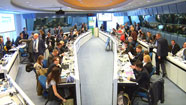On 5 April 2016 the JRC presented the interactive and collaborative online European Energy Efficiency Platform. This beta platform is conceived to fill the gap opened by scattered data and fragmented knowledge resulting from a rapidly growing energy efficiency market. It is expected to be both a one-stop shop for information retrieval and a meeting point for experts to exchange data and reduce redundant activities.
The IEA has just released the Energy Efficiency Market Report 2016
Source: http://www.iea.org/eemr16/
In the context of our new strategic focus, this report is an important step in understanding global trends in energy efficiency. It tracks the key indicators of energy intensity, energy efficiency investment and their impact. Our report finds – despite lower energy prices – progress is being made, but not fast enough. It shows where policy has made a real difference, but also highlights that much more can be achieved. It highlights the threat of a continuation of lower energy prices to the energy efficiency agenda, but also demonstrates clearly that strong, well-designed policy, can mitigate that threat.
The greatest efficiency gains have been led by policy, and the greatest untapped potentials lie where policy is absent or inadequate. There are lessons of success from around the world, including US vehicle standards, Japan’s progressive Top-Runner programme, and China’s Top 10 000 programme. The report focuses on the progress made in China. To our knowledge, China’s energy efficiency story is told in great detail for the first time by this report. It is a story of great progress, achieving huge efficiency gains over the last ten years, but also revealing the opportunity for China to achieve much more on a path to the efficiency levels of other countries.
Some highlights that you may find interesting:
- Strong energy efficiency policy is vital to achieving the central energy-policy goals of reducing energy bills, addressing climate change and air pollution, improving energy security, and increasing energy access.
- The IEA’s Energy Efficiency Market Report 2016 finds that energy efficiency improvements are speeding up, which is driving down demand, saving companies and countries money, and reducing greenhouse gas emissions.
- In 2015, USD$221 billion was invested in energy efficiency improvements.
- Energy intensity improved by 1.8% percent last year, meaning the global economy needed less energy to grow. The improvement exceeded the 1.5% gain of 2014, and was triple the average rate seen over the past decade.
- However, while much has been accomplished, global progress is still too slow. Global energy intensity improvements need to reach at least 2.6% per year to put the world on a sustained pathway for a decarbonised energy system
- Energy efficiency policies aim to deliver the maximum amount of benefit from the energy we use. For instance, car fuel economy standards around the world saved 2.3 million barrels a day of oil last year, 2.5% of the global oil supply.
- Efficiency standards now cover 30% of energy use globally, up from 11% in 2000. IEA countries saved USD 540 billion in energy expenditure in 2015 as a result of energy efficiency improvements since 2000.
- One country in particular showed significant progress, China, where energy intensity improved by 5.6%. Without this contribution, the global energy intensity improvements would have been just 1.4% in 2015.
- The IEA has also introduced the Efficiency Policy Progress Index (EPPI), which tracks mandatory policies and establishes a baseline to monitor future progress.
Link to Energy Efficiency Market Report 2016 - Digital Snapshot
IEA 2016 Energy Efficiency Market report (pdf 6.3 MB)





To quote this news use the follonwing format: